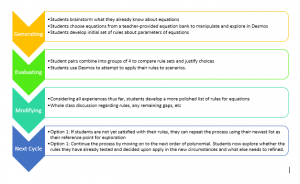In what ways would you teach an LfU-based activity to explore a concept in math or science? Draw on LfU and My World scholarship to support your pedagogical directions. Given its social and cognitive affordances, extend discussion by describing how the activity and roles of the teacher and students are aligned with LfU principles.
My school division uses the Math Makes Sense line of mathematics textbooks and programming as the main resource for math education up to Grade 9. I, and most teachers I know of, have a love-hate relationship with the approach of MMS, as it tends to be very abstract and conceptual without always including as many hands-on, nitty-gritty experiences for the students. While each lesson begins with an exploration task, these explorations are often too difficult for students when they lack a meaningful context or are really just pencil-and-paper tasks. After exploring the readings and activities this week, I have somewhat softened my perspective of MMS, however, in the sense that I believe the general approach of the programming aligns to a certain extent with LfU principles, although the execution may not always follow suit. This can be accounted for with supplemental and substitutional experiences designed by the instructor. I like to use hands-on exploration activities with my students, but I often situate them after I have provided initial instruction. LfU would dictate that students begin with rich exploration tasks, and then the teacher supports consolidation of learning afterwards.
One big take-away I gained from this week’s reading was in Perkins, Hazelton, Erickson, and Allan’s article regarding place-based education. They explained that, “Introducing GIS and GPS in the students’ familiar and immediate surroundings more easily bridges the gap between the real and digital worlds. Each student has tangible experience with their schoolyard and, therefore, some sense of that space that will allow them to construct new knowledge in the context of a place that they know” (2010, p. 217).When working with measurement in math, and specifically with unit conversions in early high school, LfU-based activities can involve students exploring the actual space of the classroom, school, and school yard to look for patterns in relationships between measurements taken using different measurement devices. Providing students with specific tools that can provide or not provide specific measurements can create a need for strategies to use the tools at hand to accomplish the task. Following an investigation of such measurements, discussion regarding patterns and trends could follow, with students also having an opportunity to ask peers questions regarding incomplete connections or misunderstandings. The teacher can help to build a common record of findings and patterns, working towards conversion rules. This investigation could be followed up with an application to a space of their choice – the rink, a baseball diamond, a theatre, with students needing to determine certain measurements in order to refurbish the space with the appropriate materials. Students are the drivers of the conceptual and skill development, with teachers taking on the role of guide and supporter.
A second concept that I feel is very important is that “The designer or teacher must also pay attention to the preparedness of the learner to receive the information and the processing and use of the information that the student will be asked to do in the learning context” (Edelson, 2001, p. 377). Teachers need to meet students where they are at, not where we think they should be. If a task offers too much challenge for a student, s/he will likely not find the motivation necessary for LfU, or may struggle with the tools themselves. As teachers, we can support students in LfU-type activities by ensuring that the learning activities and tools are equitably accessible to all students. Students who need additional supports to participate in the investigation can still explore and create their own learning, and will benefit greatly from doing so. For example, a student with weak short-term memory skills, may need a written list of steps for the process of a particular activity, but these steps can be written by the student with the assistance of a teacher or educational assistant so that they are not directive, but rather supportive of the learning exploration process. The same way that some students need glasses to see, we need to remember that some students need specialized supports or adaptations in order to be able to properly access and participate in the learning. Such supports could include strategic grouping or pairing, outlined step lists, exemplars, scribing, audio support, etc. Students with academic challenges deserve to participate in exploratory activities as much as students who do not require additional supports.
Ultimately, the teacher’s job is to provide the context for learning experiences that stimulate motivation and curiosity, support students in their problem solving skill development, gently guide students in a better direction when they get off course, and explore with the students. When students see teachers learning with them, it creates less of a perception of teachers as the keepers of all knowledge. Ths also reinforces the LfU idea that “the construction of understanding is a continuous, iterative, often cyclical process that consists of gradual advances, sudden breakthroughs, and backward slides” (Edelson, 2001, p. 377). Teachers as learners reinforces the concept of ongoing learning.
Students need to be given agency to explore and “get messy” with their learning. There are many interesting and open-ended tasks for learning in mathematics if teachers are willing to provide these opportunities for their students. In the words of one of my favourite television teachers, Miss Frizzle, teachers and students engaging in LfU-styled learning need to be willing and prepared to ‘Take chances, make mistakes, get messy!’
References:
Edelson, D.C. (2001). Learning-for-use: A framework for the design of technology-supported inquiry activities. Journal of Research in Science Teaching,38(3), 355-385. http://ezproxy.library.ubc.ca/login?url=http://dx.doi.org/ 10.1002/1098-2736(200103)38:3<355::aid-tea1010>3.0.CO;2-M
Perkins, N., Hazelton, E., Erickson, J., & Allan, W. (2010). Place-based education and geographic information systems: Enhancing the spatial awareness of middle school students in Maine. Journal of Geography, 109(5), 213-218. http://ezproxy.library.ubc.ca/login?url=http://dx.doi.org.ezproxy.library.ubc.ca/10.1080/00221341.2010.501457
